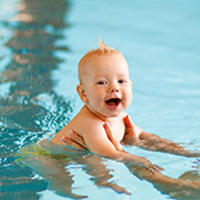Babies can drown in as little as 1 or 2 inches of water
Water safety should start the minute you leave the hospital with your newborn.


Infant CPR
Parents and caregivers should learn infant CPR before bringing their baby home from the hospital. Pool owners should know CPR and how to get emergency help.
Keep equipment approved by the U.S. Coast Guard, such as life preservers and life jackets, at the pool or lakeside.
Drownings can happen silently and within as little as 20 seconds


Infant bath safety
After your newborn’s umbilical cord has fallen off, they will be ready for a “baby bathtub” that has a contoured design or sling to prevent slipping under water.
Make swimming fun and safe for those you care for.
Sign up to get email reminders and updates on swim safety.

Infant swimming lessons are safe after your child turns 1
The American Association of Pediatrics recommends parent-child lessons as early as age one to help form safe water habits at a young age and to build swim readiness skills.

Stay within arm’s reach whenever your baby is near water
Never—even for a moment—leave a newborn or young child unattended or in the care of another child while in or near bodies of water.

Secure the pool with barriers
Install barriers or fences at least 4 feet (1.2 meters) tall that separate the pool area from the house. Make sure the barriers don’t obstruct the view of the pool from outside the fenced area.
And don’t forget to install locks and alarms on doors and windows leading to the pool area.
Pool Safety 101
The ZAC Foundation was established to prepare children and families for a lifetime of water safety. The organization works to strengthen pool safety legislation and fund advocacy, education, and effective programming surrounding water safety. Zachary’s memory is the inspiration for the Foundation’s mission and activities.






